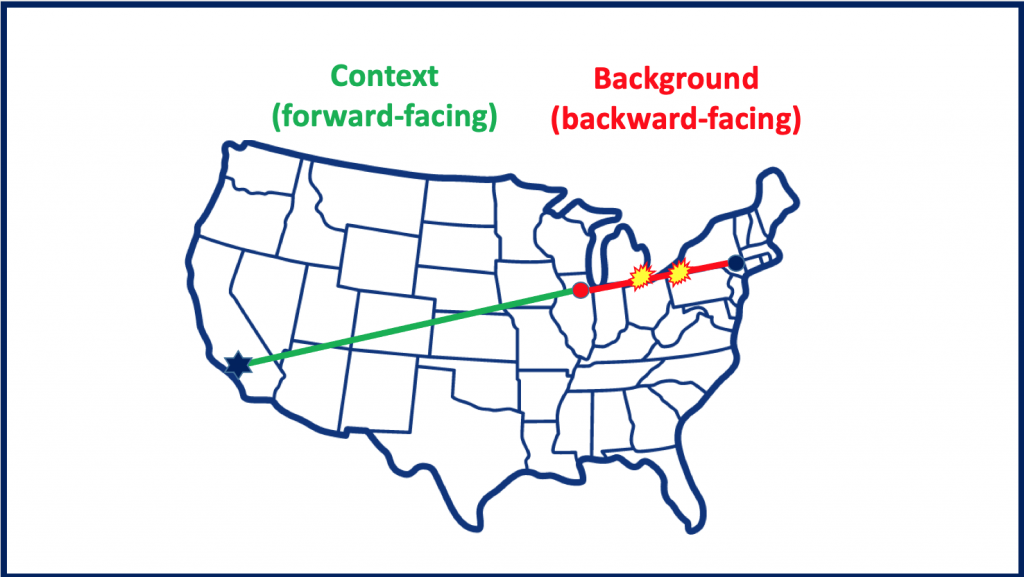Before I get going on this article, I want to give you some background.
Did you feel it? Did your eyes roll? Did your thoughts start to wander? Did you start looking down the page to get to the “real” content? Did the word “background” trigger a negative reaction?
Nothing kills engagement and decision-making as much as “background.
Ironically, most of us know this. I’ve run into very few people who like to hear the background. For most people, the background section of a presentation is an opportunity to briefly tune out.
Yet, we still include background in our presentations. While we don’t like to be the recipient of background, we somehow feel that we must provide it. It’s one of the many strange paradoxes I’ve found with communication. We often do the very things that we dislike when we are the recipient.
Of course, any good story requires some context. It’s important to get your audience’s mind in the right place to make sense of what you are telling them. But this is where we often go wrong. We confused background and context
Background is not the same as context.
Background, as its name implies is generally looks backward. It’s the story of how you arrived at your current situation. Sometimes it includes a historical review of performance, decisions, or other aspects of the business. Other times it includes the process, tools, analysis, and approach you took to arrive at your conclusion. I call this second form of background, “The story of how you came up with the story.” Either way, it’s a conversation about the past.
Context is forward looking. Context explains where you are now and why you aren’t moving forward. That’s essential to effectively prepare your audience to understand your story.
Here’s a quick example. Imagine that you have a job interview in Los Angeles on Friday morning. However, you’ve run into a problem and may not get there on time. You are seeking advice on how to solve your problem. Here’s how the story might start using a background focus versus a context focus.

Background focus. I left for California on Monday. I had decided to drive from Boston rather than fly. I thought it would be fun to take a road trip. My car broke down in New York. Because it was so late, we needed to wait until morning to have the repair made. I got back on the road Tuesday afternoon. I drove straight through the night. Then, my car broke down again late Wednesday morning. It took several hours for the tow truck to come and for the repair to be made. I finally made it to Chicago late Wednesday night. But there’s no way that I can get to California in time for my interview.
Context focus. It’s Wednesday night. I’m in Chicago. I need to be in Los Angeles on Friday morning. I could theoretically make it if I drive straight through for 30 hours. However, my car has been having issues. More importantly, I’m exhausted from driving. There’s no way that I can stay awake for another 30 hours.
Did you see the difference?
The background started the story in Boston and ended in Chicago. Most of the information, while related to my current situation, isn’t relevant to helping me figure out what to do next.
The context started in Chicago. It explained what was happening, why it was a problem, and what the core issue was. It provides a faster and more efficient path to making a decision.
Context drives decision-making. Background slows it down.
There’s a reason it’s called BACKground. Think about a theater performance. Where is the background? Think about your virtual meetings. Is your background in front of you or behind you?
Put the background in the back. In the case of a presentation or report, that means in the appendix. It’s fine to pull a few relevant points or conclusions into your context setting. But the entire history isn’t needed to help people make decisions.
Instead, lead with context. Context should answer three simple questions:
· What is the (business) issue that we are facing?
· How is this issue impacting/hurting our business?
· What is causing the issue?
Once you’ve established those three things, your audience is ready to help you make decisions.
Swapping context for background will speed up and improve your decision-making.
————-
Brad Kolar is an Executive Consultant, Speaker, and Communication Coach with Avail Advisors. Avail helps leaders simplify their problems, decisions, data, and communication. Contact Brad at brad.kolar@availadvisors.com.

